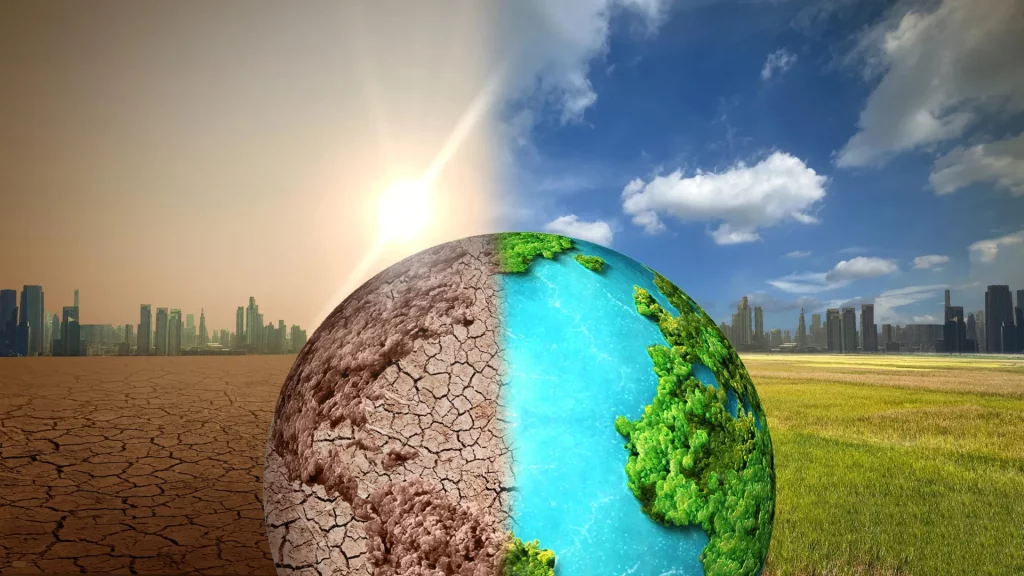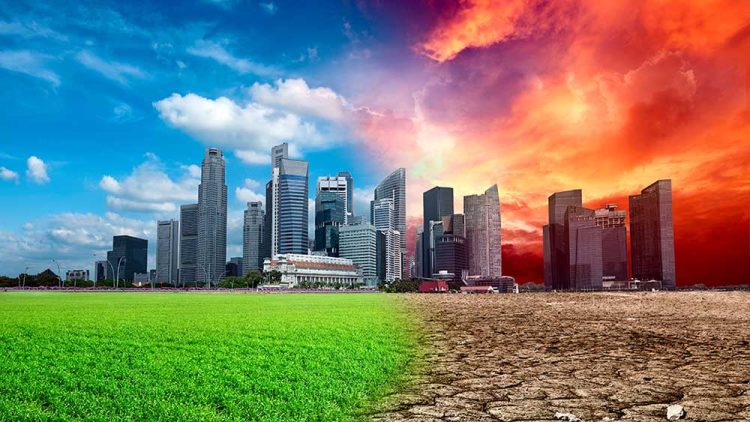Introduction
Climate change, once a distant concern, is now one of the most pressing issues facing the world today. Over the past century, human activities—especially the burning of fossil fuels, deforestation, and industrial practices—have led to significant changes in the Earth’s climate systems. These changes are marked by rising global temperatures, extreme weather events, shifting weather patterns, melting ice caps, and rising sea levels. The consequences of climate change are far-reaching, affecting ecosystems, economies, food security, and human health on a global scale.
As the impacts of climate change continue to accelerate, governments, industries, scientists, and individuals alike are working to find solutions. Climate change mitigation and adaptation strategies have become critical in the fight to limit its damaging effects. This article explores the causes of global climate change, its consequences, and the global response actions being taken to address the crisis.
1. Understanding Climate Change
1.1. What is Climate Change?
Climate change refers to long-term alterations in temperature, precipitation patterns, and other atmospheric conditions on Earth. While natural forces such as volcanic eruptions and variations in solar radiation have historically contributed to climate shifts, the current phase of rapid change is largely driven by human activity. This period of significant environmental change is often referred to as anthropogenic climate change, which stems from the emission of greenhouse gases (GHGs) into the atmosphere.
1.2. The Greenhouse Effect and Global Warming
The Earth’s atmosphere contains various gases, some of which—like carbon dioxide (CO2), methane (CH4), and nitrous oxide (N2O)—trap heat. This is known as the greenhouse effect, which helps maintain the Earth’s temperature at levels necessary to support life. However, since the industrial revolution, human activities have dramatically increased the concentration of these gases, leading to an enhanced greenhouse effect. This has resulted in global warming, which is a primary driver of climate change.
Rising global temperatures contribute to a variety of ecological, atmospheric, and oceanic changes. These include:
- Higher average global temperatures—the planet’s temperature has risen by approximately 1.2°C since the late 19th century.
- Melting polar ice and glaciers—accelerating ice loss in the Arctic and Antarctic regions, contributing to rising sea levels.
- Ocean acidification—as oceans absorb more CO2, their pH levels decrease, which affects marine life.
2. The Impact of Climate Change
2.1. Rising Sea Levels
One of the most visible and concerning effects of climate change is the rising sea levels caused by the melting of glaciers and polar ice caps. As the planet warms, the ice sheets in Greenland and Antarctica are losing mass at an accelerating rate. This, combined with the thermal expansion of seawater as it warms, is causing sea levels to rise, putting coastal regions at risk of flooding.
Low-lying countries and islands, particularly in the Pacific and Indian Oceans, face the threat of becoming uninhabitable. Major cities around the world, such as New York, Miami, Mumbai, and Jakarta, are also vulnerable to sea-level rise, posing a direct threat to millions of people.
2.2. Extreme Weather Events
Climate change is increasing the frequency and intensity of extreme weather events, including hurricanes, droughts, floods, heatwaves, and wildfires. For example, rising temperatures are linked to stronger and more frequent hurricanes and cyclones in tropical and subtropical regions. Similarly, prolonged heatwaves and droughts are becoming more common, putting pressure on water resources and agriculture.
The economic and human toll of extreme weather events is enormous. Disasters like hurricanes and wildfires not only lead to loss of life but also result in billions of dollars in damages, displacing communities and straining national economies.
2.3. Threats to Biodiversity
Changes in climate are disrupting ecosystems and threatening biodiversity. Species that are unable to adapt quickly to changing conditions, such as temperature shifts, altered rainfall patterns, and loss of habitat, are at risk of extinction. For instance, coral reefs—often considered the “rainforests of the sea”—are suffering from bleaching due to rising sea temperatures, which devastates marine life.
Additionally, migratory patterns are changing as species try to cope with shifting climates. Plants and animals that once thrived in certain climates are now being forced to migrate or face extinction. The loss of biodiversity has significant implications for ecosystem stability, food security, and the livelihoods of people dependent on natural resources.
2.4. Impact on Agriculture and Food Security
Climate change affects agriculture in various ways. Increased temperatures and unpredictable rainfall patterns impact crop yields, reducing food production in many regions. Droughts and heatwaves have been shown to reduce the productivity of key crops such as wheat, rice, and maize, which are staples for billions of people.
Moreover, shifts in the climate can alter pest populations, resulting in new agricultural challenges. For example, warming temperatures may enable pests such as mosquitoes and locusts to thrive in new regions, affecting crop health and human populations.
2.5. Human Health
The consequences of climate change extend to human health as well. Rising temperatures contribute to the spread of diseases that are transmitted by vectors such as mosquitoes, including malaria and dengue fever. Extreme heat can lead to heat-related illnesses and deaths, particularly in vulnerable populations such as the elderly and children.
In addition, air pollution exacerbated by climate change can worsen respiratory diseases like asthma. Flooding and other extreme weather events can also lead to the spread of waterborne diseases, putting additional strain on healthcare systems.

3. Global Climate Change Response Actions
3.1. International Agreements
The global nature of climate change requires international cooperation. Numerous agreements have been established to address the crisis, the most significant being the Paris Agreement, adopted in 2015 under the United Nations Framework Convention on Climate Change (UNFCCC). The agreement aims to limit global warming to below 2°C, with efforts to limit it to 1.5°C, compared to pre-industrial levels.
Countries that are parties to the Paris Agreement have pledged to reduce their greenhouse gas emissions through nationally determined contributions (NDCs). While progress has been made, the gap between current pledges and the level of emission reductions required to meet the 1.5°C target remains significant.
3.2. Climate Mitigation Strategies
Mitigation refers to efforts to reduce or prevent the emission of greenhouse gases. Key mitigation strategies include:
- Renewable Energy Transition: One of the most important steps in combating climate change is transitioning from fossil fuels to renewable energy sources such as solar, wind, hydro, and geothermal. These energy sources produce little to no greenhouse gas emissions and are crucial for reducing the carbon footprint of power generation.
- Energy Efficiency: Improving energy efficiency in industries, transportation, and buildings can significantly reduce emissions. This includes adopting energy-efficient technologies, promoting public transportation, and reducing waste in manufacturing processes.
- Carbon Capture and Storage (CCS): CCS technologies aim to capture CO2 emissions from industrial sources and store them underground, preventing them from entering the atmosphere. While still in the early stages of development, CCS could play a critical role in achieving net-zero emissions.
- Reforestation and Afforestation: Forests act as carbon sinks, absorbing CO2 from the atmosphere. Reforestation (planting trees in deforested areas) and afforestation (planting trees in areas that have never been forested) are key strategies to reduce carbon concentrations.
3.3. Climate Adaptation Strategies
Adaptation refers to the actions taken to adjust to the changing climate and reduce the harm caused by its effects. These strategies are critical, especially for communities that are already experiencing the impacts of climate change. Key adaptation strategies include:
- Building Resilience in Infrastructure: Coastal communities, for example, need to invest in flood defenses such as sea walls, while cities may need to redesign urban areas to withstand heatwaves and extreme weather events. Infrastructure should be made more resilient to climate impacts through smarter city planning and engineering.
- Water Resource Management: As droughts and water scarcity increase in many regions, managing water resources efficiently is becoming increasingly important. This includes improving irrigation systems, promoting water conservation, and investing in water recycling and desalination technologies.
- Agricultural Adaptation: Farmers need to adapt to new climate conditions by adopting more resilient farming practices. This might involve switching to drought-resistant crops, improving soil management, or utilizing precision agriculture technologies to optimize resource use.
- Public Health Systems: Strengthening public health systems is crucial for addressing the health risks posed by climate change. This includes preparing for the spread of vector-borne diseases, providing better access to healthcare, and improving early warning systems for extreme weather events.
3.4. Role of the Private Sector
The private sector plays an essential role in combating climate change. Corporations can contribute to both mitigation and adaptation efforts by:
- Sustainable Business Practices: Companies can adopt sustainable supply chains, reduce waste, and invest in green technologies.
- Green Finance: Investment in sustainable and low-carbon technologies, such as renewable energy and green bonds, is critical to driving the transition to a low-carbon economy.
- Corporate Responsibility: Many companies are setting science-based targets for emissions reductions and committing to carbon neutrality by mid-century. Corporate leadership in climate action can have a ripple effect, encouraging other industries to follow suit.
4. Challenges in Climate Action
Despite the progress made in climate response, several challenges remain:
- Political and Economic Resistance: Climate change policies often face opposition due to concerns about their economic impact, especially in industries reliant on fossil fuels. Political will and cooperation among countries are essential for effective action.
- Inequality: Climate change disproportionately affects poorer nations and vulnerable communities. Addressing these inequalities requires international support and resources, especially in terms of finance and technology transfer.
- Technological Barriers: While technologies like carbon capture and renewable energy are promising, their widespread adoption faces technical, financial, and infrastructure challenges.
- Global Coordination: The decentralized nature of climate change action means that global cooperation is difficult to achieve. However, international agreements and frameworks are crucial in ensuring that all countries contribute to mitigation and adaptation efforts.
Conclusion
Global climate change represents one of the greatest challenges humanity has ever faced. The impacts of climate change are far-reaching and will continue to escalate unless immediate and decisive action is taken. Mitigation and adaptation strategies must be integrated into national and global policies to reduce emissions, protect ecosystems, and ensure resilience in the face of changing conditions.
While the path forward is fraught with challenges, there is hope in the ongoing efforts by governments, the private sector, and individuals to combat climate change. The world has the tools, knowledge, and capacity to tackle this crisis, but it requires unified global action, innovative solutions, and sustained commitment.
The time for action is now. The future of our planet depends on the choices we make today.











































